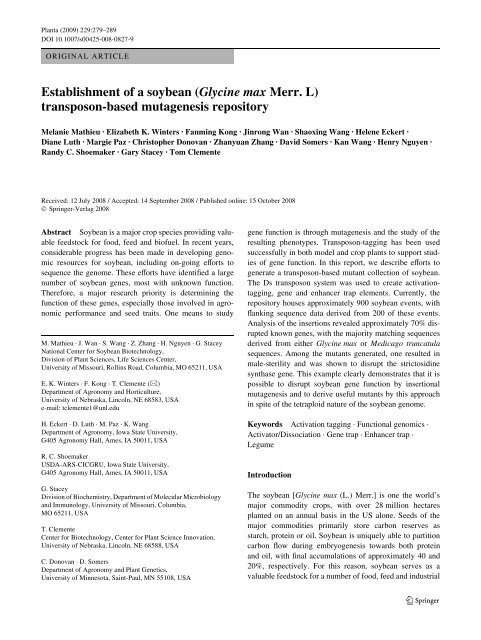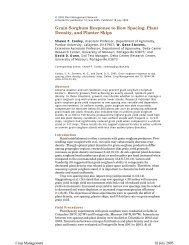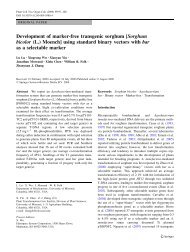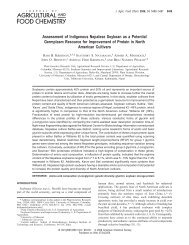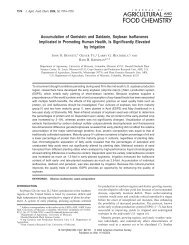Establishment of a soybean (Glycine max Merr. L ... - Plant Sciences
Establishment of a soybean (Glycine max Merr. L ... - Plant Sciences
Establishment of a soybean (Glycine max Merr. L ... - Plant Sciences
You also want an ePaper? Increase the reach of your titles
YUMPU automatically turns print PDFs into web optimized ePapers that Google loves.
280 <strong>Plant</strong>a (2009) 229:279–289applications. A number <strong>of</strong> <strong>soybean</strong> genomics studies arebeing targeted to address this unique feature <strong>of</strong> <strong>soybean</strong>,along with avenues to improve agronomics <strong>of</strong> the crop,including yield and protection <strong>of</strong> yield by modulating toleranceto stress (Shoemaker et al. 2003; Stacey et al. 2004).Detailed genetic and physical maps <strong>of</strong> the <strong>soybean</strong> genomehave been generated (Shoemaker et al. 2008). Recently, a7£ draft sequence <strong>of</strong> the <strong>soybean</strong> gene space was releasedleading to estimate that the genome encodes 45-60,000genes. Statistics provided by the Phytozome website (http://www.phytozome.net/<strong>soybean</strong>.php#B) predict 58,556 locicontaining protein-coding transcripts and 62,199 total transcripts.It will be imperative to develop a diverse set <strong>of</strong>tools to assign function to the predicted gene sequences inorder to translate this genomic information to applied technologies(Jackson et al. 2006).The ability to speciWcally modulate gene expression representsan extremely powerful approach to directly characterizegene function. Down-regulation <strong>of</strong> genes througheither transcriptional or post-transcriptional gene silencingis a useful tool for functional genomics (Cigan et al. 2005)and has been used to study <strong>soybean</strong> gene function (Buhret al. 2002; Kinney et al. 2001; Nunes et al. 2005; Shi et al.2007; Subramanian et al. 2005). However, there are a number<strong>of</strong> drawbacks with down-regulation via a stable genesilencing approach. For example, multiple transformantsare generally required to identify a down-regulated event,essential genes are diYcult to characterize because thedominant lethal phenotype cannot be maintained in the heterozygousstate, and, if the silencing element is notdesigned properly, modulation <strong>of</strong> a entire gene family mayoccur or “oV-target” genes may be aVected, thereby complicatinghypothesis testing.Insertional mutagenesis is another means by which geneexpression can be modulated in plants. T-DNA tagged populationsin Arabidopsis have proven to be a very usefulfunctional genomics resource and a signiWcant eVort hasbeen made to establish a similar repository in rice (An et al.2003) and maize (Cowperthwaite et al. 2002). However,although development <strong>of</strong> a T-DNA insertional mutantrepository in <strong>soybean</strong> is technically possible, it wouldrequire a tremendous amount <strong>of</strong> labor to acquire a suYcientnumber <strong>of</strong> insertions to be <strong>of</strong> value. This is largely due tothe fact that, while <strong>soybean</strong> transformation is now routine(Parrott and Clemente 2004), the process is slow (»5–7 months) and laborious. Each T-DNA event would requirean independent transformation and this alone makes theapproach impractical. A useful route to circumvent the needfor a large population <strong>of</strong> primary <strong>soybean</strong> transformants isto couple T-DNA regions with transposon-based elements.Since T-DNA insertions tend to reside in transcriptionalactive regions <strong>of</strong> a chromosome, a distribution <strong>of</strong> such elementsthroughout the genome would provide launchingsites for further mutagenesis upon activation <strong>of</strong> transposition.Two maize transposon families have been eVectively utilizedin heterologous plant systems for gene tagging, Activator/Dissociation(Ac/Ds) (Gidoni et al. 2003; Izawa et al.1997; Jones et al. 1994; Kolesnik et al. 2004) andEnhancer/Suppressor-mutator (En/Spm) (Marsch-Martinezet al. 2002; Speulman et al. 1999). A two component transposonsystem as a tool to probe a plant genome, when combinedwith T-DNA as a means to introduce the mobileelements, facilitates a regional mutagenesis design, giventhe tendency <strong>of</strong> maize elements to transpose locally (Joneset al. 1990; Knapp et al. 1994; Long et al. 1997).A drawback associated with random mutagens witheither T-DNA alone or T-DNA coupled with transposableelements, is that many intriguing gene disruptions may bemissed due to lack <strong>of</strong> an obvious phenotype. This limitationcan be addressed by employing gene and enhancertrap elements with a transposon-based strategy (Sundaresanet al. 1995). A gene trap element lacks a promoter, but carriesjust upstream <strong>of</strong> a visual marker gene, a triple spliceacceptor and a short intron (Martienssen 1998) allowingactivation <strong>of</strong> visual marker gene expression when the elementis integrated into either an exon or intron <strong>of</strong> a genicregion. The enhancer trap element harbors a visual markergene coupled with a minimal 35S CaMV promoter that isnot functional unless it is placed in the proximity <strong>of</strong> anendogenous enhancer element (Martienssen 1998). A positiveattribute <strong>of</strong> employing gene and enhancer trap elementsis that expression <strong>of</strong> the marker gene triggered bythe integration <strong>of</strong> the respective trap into a gene regiontends to mirror that <strong>of</strong> the tagged gene (Sundaresan et al.1995).In addition to the limitations associated with interruptinggene expression as a means to elucidate function, the abilityto gather data from either insertional or down-regulationapproaches may be complicated due to gene redundancymasking the phenotype. This could be <strong>of</strong> greater importancein a paleopolyploid such as <strong>soybean</strong>. Implementing again <strong>of</strong> function approach tool can circumvent these pitfalls.Misexpression mutants can be generated by transformingplants with multiple enhancer sequences(Imaizumi et al. 2005; Jeong et al. 2006; Nakazawa et al.2003). With respect to a high oil/protein-producing seedsuch as <strong>soybean</strong>, implementing seed-speciWc promoters inactivation tagged elements would provide an additional aidfor elucidating gene function.Therefore, our current work is intended to evaluate thefeasibility <strong>of</strong> using the Ds transposon as an eVective tool formutagenesis <strong>of</strong> <strong>soybean</strong>. The long-term goal <strong>of</strong> this programis to establish a functional genomics resource that willcomplement the wealth <strong>of</strong> “-omics” tools currently availablefor <strong>soybean</strong> including a plethora <strong>of</strong> SSR (Cregan et al.123
<strong>Plant</strong>a (2009) 229:279–289 2811999; Song et al. 2004) and SNP (Zhu et al. 2003) markers,physical, genetic and transcript maps (Choi et al. 2007;Kassem et al. 2006; Shultz et al. 2007), and reliable transformationsystems (Parrott and Clemente 2004).Materials and methodsVectors used for <strong>soybean</strong> transformationThe set <strong>of</strong> activation tagging constructs consists <strong>of</strong> twoopposing, outward directed regulatory elements, subclonedin between Ds termini within the plasmid pBBDs/Xho (giftfrom CliV Weil, Purdue University) was assembled. Theplasmid pBBDs/Xho carries a mini-Ds element, consisting<strong>of</strong> Ac residues 1–245 and 4194–4565 with an Xho I linkerbetween the termini. The respective Ds-delineated activationtagging elements were cloned into the binary vectorpPTN200, a derivative <strong>of</strong> pPZP200, that carries a bar genecassette under the control <strong>of</strong> the Agrobacterium tumefaciensnopaline synthase promoter, Pnos, or into a pPZP200 derivativeharboring a hpt gene (Gritz and Davies 1983) cassetteunder the control <strong>of</strong> the Pnos promoter (Fig. 1a).Gene and enhancer trap elements, delineated by Ds termini,were subcloned from pWS42 and pWS41 (gift fromRob Martienssen, Cold Spring Harbor Laboratory, NewYork) as Sst I fragments and subcloned to the binary plasmidpPTN130 (not shown). The binary vector pPTN130 isa derivative <strong>of</strong> pPZP200 (Hajdukiewicz et al. 1994), harboringthe cauliXower mosaic virus 35S CaMV bar gene(Thompson et al. 1987) cassette. The resultant plasmidscarry the enhancer and gene trap elements are referred topPTN335 and pPTN336 (Fig. 1b), respectively.An Ac-transposase cassette was assembled from an AccDNA harbored in the vector pSJ176D8 (gift from CliVWeil, Purdue University), the cDNA was re-cloned downstream<strong>of</strong> the 35S CaMV promoter and 35S CaMV terminatorregion derived from plasmid pRTL 2 (Carrington andFreed 1990), with the TEV leader sequence deleted. Theresultant 35S CaMV Ac-transposase cassette was subclonedto the binary vector pPTN200 and the Wnal binaryplasmid designated pPTN398 (Fig. 1c).Soybean transformationSoybean (<strong>Glycine</strong> <strong>max</strong> <strong>Merr</strong>.) transformations were conductedvia Agrobacterium-mediated gene transfer using thecotyledonary-node explant employing either glufosinate(Xing et al. 2000; Zhang et al. 1999) or hygromycin (Olh<strong>of</strong>tet al. 2003) as selection agents. The respective binary plasmidswere mobilized into A. tumefaciens strain EHA101(Hood et al. 1986) via conjugal transfer using the helperplasmid pRK2013. The resultant transconjugants were usedFig. 1 Vectors used for <strong>soybean</strong> transformation. a Diagrammatic representation<strong>of</strong> the Ds delineated regions <strong>of</strong> the respective activation tagelements (pGly: Glycinin 1 promoter, 0.7 kb; pLect: Lectin promoter,1.85 kb; p35S: 4 £ 35S enhancer, 1.36 kb; pPhas: Phaseolin promoter,0.32 kb). Note: Ds elements indicated by shaded box. b Diagrammaticrepresentation <strong>of</strong> the Ds delineated regions <strong>of</strong> enhancer trap,pPPTN335, and gene trap, pPTN336 vectors. ‘P’ and ‘A’ refer to minimal35S CaMV promoter and splice acceptor, respectively. Direction<strong>of</strong> the visual marker gene GUS and secondary screenable marker genecassette npt II. c Diagram <strong>of</strong> T-DNA region <strong>of</strong> binary vector pPTN398.‘R’ and ‘L’ refer to right and left border region, respectively. P35 refersto 35S CaMV promoter, Ac indicates cDNA <strong>of</strong> maize Ac transposase.T35 indicates 3 poly AAA signal <strong>of</strong> 35S CaMV terminator. Pn indicatesA. tumefaciens nopaline synthase promoter. Tn refers to A. tumefaciensnopaline synthase poly AAA signalfor <strong>soybean</strong> transformations with genotypes ‘Bert’ (University<strong>of</strong> Minnesota) or ‘Thorne’ (The Ohio State University).Characterization <strong>of</strong> <strong>soybean</strong> transformantsPrimary transformants were established and grown to maturityunder greenhouse conditions. Inheritance <strong>of</strong> the foreignalleles was monitored either by a herbicide leaf paintingassay (Zhang et al. 1999) for the transgenic events derivedfrom vectors carrying the bar gene cassette or via PCR forthe events derived from constructs harboring hpt geneselection cassette. Southern blot analysis was carried out toestimate the number <strong>of</strong> integration loci per event. Totalgenomic DNA, between 10 and 20 μg, was digested with arestriction enzyme for which only one recognition sequenceis present within the respective T-DNA element. Thedigested DNA was separated by agarose gel electrophoresisprior to transfer to a nylon matrix. Membranes were hybridizedwith ether 32 P-labled GUS ORF (pPTN335 and123
<strong>Plant</strong>a (2009) 229:279–289 283Lectin/Gly and Phas/Gly plasmids (Fig. 1a). The repositorycurrently houses over 900 events, including approximately150 events derived from the enhancer and gene trap vectors,pPTN335 and pPTN336. To date 200 events in the repositoryhave been analyzed at the molecular level. The data revealedthat the transformants carry between 1 and 5 loci <strong>of</strong> the foreignalleles, with approximately 50% single locus events and20% harboring two loci. These numbers are in general agreementwith previous reports on <strong>soybean</strong> transformation withAgrobacterium tumefaciens (Clemente et al. 2000). Junctionfragments were captured from 125 <strong>of</strong> the 200 events characterized.Junctions were captured following either walking-(Devic et al. 1997) or TAIL- (Ratet et al. 2006) PCR. From54 <strong>of</strong> the events a single junction/sequence data wasobtained, while 43 events provided 2 junction/sequences andthe remaining 28 events produced 3 or 4 junction/sequences.These numbers reXect the frequency <strong>of</strong> foreign loci observedby Southern blotting using a Ds probe and demonstrate thatsequence information can be reliably gathered on junctionfragments from a multi-loci event.Sequence data obtained from the cloned junction fragmentswere queried against NCBI public database usingBLASTN (Altschul et al. 1997). A signiWcant hit wasobserved from approximately 70% <strong>of</strong> the sequences analyzed,with the majority matching sequences from either<strong>Glycine</strong> <strong>max</strong> or Medicago truncatula (Table 1).Among the gene and enhancer trap transgenic <strong>soybean</strong>events, 48 were monitored for GUS activation, representing29 pPTN335 events and 19 pPTN336 events, which wouldimply the T-DNA element landed proximal to an endogenouspromoter (enhancer trap) or within a genic region(gene trap). Tissue samples were assayed from roots,leaves, Xowers, pods and seeds using the histochemicalassay for the enzyme (JeVerson et al. 1987). Among the 29pPTN335 events screened 11 displayed GUS expression inat least one <strong>of</strong> the tissues sampled. One <strong>of</strong> the events, designated456-1 is shown in Fig. 2. GUS expression wasobserved in both Xower and pod endocarp (Fig. 2a, b).While among the 19 pPTN336 events monitored eight displayedGUS expression in at least one <strong>of</strong> the tissues sampled.Event 456-1 carries the enhancer trap element <strong>of</strong>pPTN335. Flanking sequences obtained about the leftand right border elements from insert carried in event456-1 indicated the T-DNA integrated within theupstream region <strong>of</strong> a locus (GenBank Acc. DQ208939)that encodes for a <strong>soybean</strong> hydrophobic seed protein precursordesignated HPS1.5 (Gijzen et al. 2006, 1999). Theenhancer trap T-DNA element resides 4.1 kb upstreamfrom the HPS1.5 ORF (Fig. 2). Although the HPS1.5locus is tagged, expression is not interrupted (data notshown).Table 1 Database matches observedfrom 22 cloned junctionsEvent Vector Jun Hit E-value442-1 pPTN335 RB M. truncatula clone MTH2-49119 9.0e¡12444-1 pPTN335 LB A.thaliana hydrolase (NM127180) 8.0e¡26448-8 pPTN335 LB G. <strong>max</strong> (AC166091) 1.0e¡79452-17 pPTN336 LB G. <strong>max</strong> auxin up RNA gene cluster 2.0e¡46452-26 pPTN335 RB A. thaliana AtGRF6 mRNA 7.0e¡28452-27 pPTN335 RB G. <strong>max</strong> (AC160454) 8.0e¡93452-28 pPTN336 LB G. <strong>max</strong> auxin up gene (S44177) 9.0e¡48453-31 pPTN336 RB G. <strong>max</strong> EST EV278484 5.0e¡77453-56 pPTN336 LB G. <strong>max</strong> EST (AW508443) 9.0e¡17454-4 pPTN335 LB L. japonicus trans. factor nsp2 2.0e¡42456-1 pPTN335 RB G. <strong>max</strong> HPS1.5 gene 8.0e¡128444-21 pPTN335 RB G. <strong>max</strong> (F021101) 5.0e¡78ST37-32 Phas/Gly LB P. vulgaris storage protein (J0126.1) 4.0e¡141ST36-53 p35S-Gly LB M. truncatula (CT009545) 9.0e¡52Ds1 p35S-hpt LB G. <strong>max</strong> EST Gm-c1039-1810(BE21088) 4.0e¡55Ds22 p35S-hpt LB G. <strong>max</strong> EST (AW100029) 1.0e¡54DS82-1 p35S-hpt LB G. <strong>max</strong> TRS3 (AF297985) 9.0e¡155Ds82-2 p35S-hpt LB Ribosomal protein (AF19171) 1.0e¡77Ds82-3 p35S-hpt LB G. <strong>max</strong> strictosidine synthase 1.0e¡144DS94-1 p35S-hpt LB G. <strong>max</strong> EST Gm-c1068-3456 (B1893344) 0.003Ds94-2 p35S-hpt LB G. <strong>max</strong> EST Gm-c1084 (BQ080444) 0.003Ds94-3 p35S-hpt LB G. <strong>max</strong> EST Gm-c1051-8286 (BI320753) 0.007123
<strong>Plant</strong>a (2009) 229:279–289 285Fig. 4 Microscopic analysis <strong>of</strong>pollen grains <strong>of</strong> event Ds82 andcontrol <strong>soybean</strong>. Comparison <strong>of</strong>mutant panels (a), (c) and (e) andcontrol panels (b), (d) and (f).Anthers <strong>of</strong> open Xowers. The anthers(size and shape) in the (a)mutant are identical to the control(b). While anthers <strong>of</strong> mutantplants displayed no pollen, anthers<strong>of</strong> the wild-type were fullydehisced and released pollengrains. Scale bars 250 μm. Alexander’sstained anthers. TheAlexander’s stain can distinguishbetween pollen grains thataborted in development (coloredin blue) from viable mature grainpollen (colored in purple). TheAlexander’s stain <strong>of</strong> anthers revealedthat the pollen from themutant was aborted (c) (colorblue) and the pollen from thewild-type (d) was alive (colorpurple). Alexander’s stain <strong>of</strong>pollen grains, mutant (e) displayeda light blue color whilethe pollen from the wild type (f)was purple. Note: Scalebars 500 μm a through d, and50 μm e and fposition in F 2 individuals was observed from two crosses,based on appearance <strong>of</strong> new hybridizing GUS signals inindividuals over development (Fig. 8) and germinal transposition(i.e. inheritance <strong>of</strong> the new band) in F 3 individualsfrom one cross (data not shown).DiscussionTo complement the wealth <strong>of</strong> genomics resources currentlyavailable for <strong>soybean</strong>, including the recently released 7£draft sequence <strong>of</strong> the gene space, a number <strong>of</strong> programs areactively pursuing various mutagenesis approaches toaddress the functional characterization <strong>of</strong> genes. For example,both TILLING (Cooper et al. 2008) and fast neutronirradiation (Specht et al. 2007) approaches are beingapplied to <strong>soybean</strong>. These and other down-stream functionalgenomics tools hold great promise to the <strong>soybean</strong>community for aiding in translation <strong>of</strong> genomics data intoinformation that will ultimately beneWt crop performance.These approaches also support eVorts to gain a better, basicunderstanding <strong>of</strong> <strong>soybean</strong>; such as the basic biology <strong>of</strong> theseed (Le et al. 2007) and whole plant development andstress response (VandenBosch and Stacey 2003). The goal<strong>of</strong> our work was to gauge the feasibility <strong>of</strong> using the Dstransposon as an eVective tool for insertional mutagenesis<strong>of</strong> <strong>soybean</strong>.The frequency <strong>of</strong> GUS activation observed in the <strong>soybean</strong>events carrying gene trap and enhancer trap elementswas approximately 40%. This reXects the tendency <strong>of</strong> T-DNA to integrate within transcriptionally active areas,which is likely enriched for due to the selection regimeimposed during transformation (Kim et al. 2007). Theenriching for T-DNA integration in transcriptionally activeregions is an ideal mechanism to establish strategic Dslaunch sites within the genome for targeted regional mutagenesis.Importantly, mapping <strong>of</strong> the Ds launch sites will begreatly facilitated with the availability <strong>of</strong> the sequencedgene space. As the <strong>soybean</strong> genome sequence is Wnalizedand integrated with the genetic map (Jackson et al. 2006), it123
<strong>Plant</strong>a (2009) 229:279–289 287Fig. 8 Putative somatic Ds transposition in the <strong>soybean</strong> genome. F 2individuals derived from a cross between Ac-transposase parent 538-5used as male and pPTN335 event 457-13 used as female. Lanes designatedwith ‘U’ and ‘L’ refer to upper and lower leaf tissue samples.Lanes under F 2-8 are double null. Ds lanes are samples from femaleparent, while Ac lanes are male parent + and ++ lanes indicate 50 pg <strong>of</strong>pPTN335 and pPTN398, respectively. Blot was hybridized with GUSORFDNA with transposon-based systems as the delivery vehiclefor activation tag elements allows for the launch sitesto be strategically situated within transcriptionally activeregions <strong>of</strong> the genome. Moreover, multicopy integrations<strong>of</strong>ten occur with T-DNA and some chromosomal perturbationmay be induced proximal to the site <strong>of</strong> integration(Kim et al. 2003; Ohba et al. 1995; Olh<strong>of</strong>t et al. 2004),which may impact the activation <strong>of</strong> a nearby gene.Coupling T-DNA with transposon-based systems circumventsthis potential problem given the movement <strong>of</strong> thetransposon from the original site to the new location willresult in a single copy intact integration with fewer proximalrearrangements in the genome (Marsch-Martinezet al. 2002).Limited information is available on the activity <strong>of</strong> themaize Activator in the <strong>soybean</strong> genome (Aljanabi et al.1999; Zhou and Atherly 1990). We demonstrated here putativesomatic and germinal transposition <strong>of</strong> Ds is induced inthe <strong>soybean</strong> genome upon stacking a constitutive Ac-cDNAexpression cassette, with a non-autonomous Ds allele.However, one <strong>of</strong> the drawbacks <strong>of</strong> inducing Ds transpositionwith a constitutive Ac cassette is that somatic transpositionstend to be more frequent than germinal. In addition,transposition can occur throughout plant development,which may complicate cloning <strong>of</strong> the desired tagged gene.To circumvent these potential pitfalls associated with theuse <strong>of</strong> a constitutive Ac transposase, we assembled an Accassette under the control <strong>of</strong> the Arabidopsis meiosis-speciWcDMC1 promoter (Klimyuk and Jones 1997). Transgenic<strong>soybean</strong> events carrying this latter Ac cassette willpermit comparative studies designed to monitor germinalDs transposition frequencies induced upon stacking <strong>of</strong> theconstitutive verses meiosis-speciWc transposase expression.Clearly data gathered from such a study, monitoring theaVect <strong>of</strong> Ac expression over development and level on thefrequency <strong>of</strong> Ds transposition in the <strong>soybean</strong> genome, willbe a key factor that determines the ultimate power <strong>of</strong> thismaize two component transposon system as a tool for functionalgenomics in the crop.The limited screening <strong>of</strong> the events currently housed inthe transposon-based <strong>soybean</strong> collection has revealed thatlaunch sites established by T-DNA integration tend toreside in gene rich regions (Table 1). Analysis <strong>of</strong> genesequences across taxa provided insight into what transgeniclocus may be linked with the male sterile phenotypeobserved in event Ds82, highlighting the power <strong>of</strong> comparativegenomics brought about by the previous investmentsmade in plant genomics.Arguably one <strong>of</strong> the most critical components that willenable a transposon-tagged repository to be <strong>of</strong> value to the<strong>soybean</strong> community is the establishment <strong>of</strong> a reliable identity-preservedstorage and distribution system. Importantly,the collection must be linked to a user-friendly searchabledatabase. To this end we developed GmGenesDB (http://digbio.missouri.edu/gmgenedb/index.php). This databasehas a set <strong>of</strong> tools to Wnd insertions in gene(s) <strong>of</strong> interest, andto retrieve all annotations related to a tagged gene. Additionalinformation <strong>of</strong> the respective <strong>soybean</strong> events housedin the repository includes foreign locus number, genotype<strong>of</strong> the event, and phenotype observed. The ultimate goal <strong>of</strong>this program is to provide a resource to the <strong>soybean</strong> communityto facilitate the translation <strong>of</strong> the basic tools toapplied technologies that can be exploited for downstreamimprovements in <strong>soybean</strong> genetics.Acknowledgments This work was supported by grants providedthrough USDA/NRI Award No. 2002-35301-12195, and the UnitedSoybean Board. Additional funds provided through the National Centerfor Soybean Biotechnology and Nebraska Research Initiative.ReferencesAljanabi SM, Shibli R, Ajlouni M (1999) Insertion <strong>of</strong> maize transposableelement Ac into <strong>soybean</strong> (glycine <strong>max</strong> L. <strong>Merr</strong>.) by Agrobacteriummediated transformation method. Dirasat. Agric Sci26:226–239Allen RD, Bernier F, Lessard PA, Beachy RN (1989) Nuclear factorsinteract with a <strong>soybean</strong> β-conglycinin enhancer. <strong>Plant</strong> Cell 1:623–631Altschul SF, Madden TL, SchäVer AA, Zhang J, Zhang Z, Miller W,Lipman DJ (1997) Gapped BLAST and PSI-BLAST: a new generation<strong>of</strong> protein database search programs. Nucleic Acids Res25:3389–3402An S, Park S, Jeong D-H, Lee D-Y, Kang H-G, Yu J-H, Hur J, Kim S-R, Kim Y-H, Lee M, Han S, Kim S-J, Yang J, Kim E, Wi SJ,Chung HS, Hong J-P, Choe V, Lee H-K, Choi J-H, Nam J, KimS-R, Park P-B, Kim WT, Choe S, Lee C-B, An GH (2003) Generationand analysis <strong>of</strong> end sequence database for T-DNA tagginglines in rice. <strong>Plant</strong> Physiol 133:2040–2047Benfey PN, Chua NH (1990) The cauliXower mosaic virus-35spromoter—combinatorial regulation <strong>of</strong> transcription in plants.Science 250:959–966Buhr T, Sato S, Ebrahim F, Xing A, Zhou Y, Mathiesen M, SchweigerB, Kinney AJ, Staswick P, Clemente T (2002) Ribozyme123


